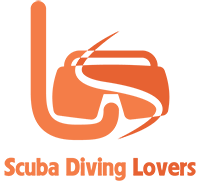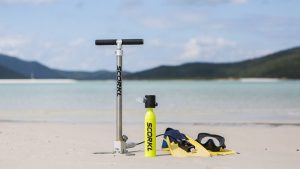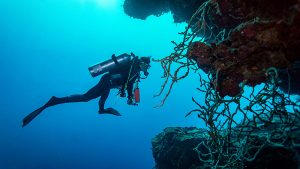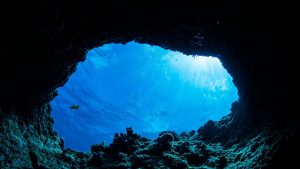There are many free diving dangers, so if you love this sport, you should be very cautious about this. Fatalities have been reported at one time or another. Freediving is also referred to as One Breathe. Divers take one breathe, dive as deep as they can and hold that breathe until they come out. This means they do not carry tanks or any source of oxygen. Holding breathe, as dangerous as it could be, is so beautiful. It portrays the unnatural and very powerful traits of survival for human beings. Although it is not an adventure for the faint of heart, free diving is pure fun.
Divers participate in this activity for fun or as sport. The act of one breath – before it was declared as sport – entailed women and men diving deeply for different purposes. For instance, Romans free dived to build barriers under oceans, while Greeks dived for sponges. Koreans and Japanese dive to get pearls and oysters, which they have done for over 2,000 years.
Today, air-free diving portrays the potential of people to emerge into the deepest areas of the sea with a single breath. Their ability to hold a single breath and their determination to stay alive is their source of motivation. Initially, the aspect of diving air-free came from the need to recover lost items, for tradable valuables, or for food. Nonetheless, in the modern times, people take free diving as a recreational activity. They dive underwater for sport, to gather food and even capture photos.
In fact, one breath diving has become a competitive sport. In many competitions, individuals, countries and teams participate. The winners get prizes and cash.
Competitive free diving has lead to the evolution of different kinds of free diving such as your will see below.
Table of Contents
freediving techniques
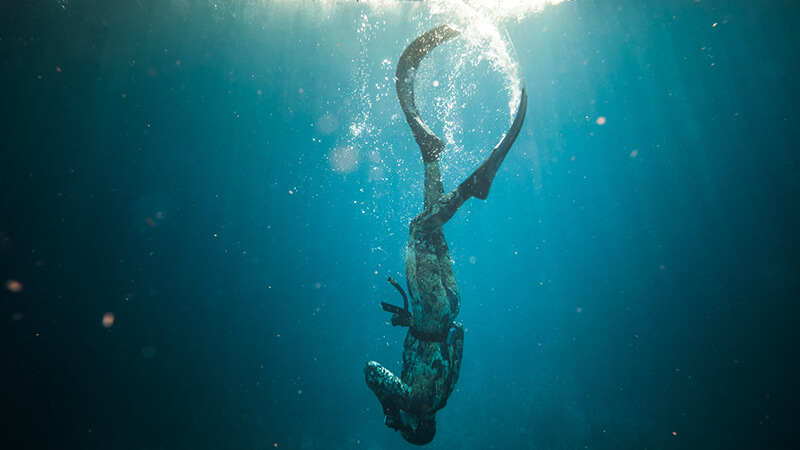
You do not just take a deep breath, hold it in and dive. There are different ways to do that, and that is why this section is about the best freediving techniques to adopt. Here is a sneak peek at a few of the techniques:
Constant Weight Free diving
CWF (Constant Weight Free diving) – diver can wear fins or can even dive without. It is the safest type, where people dive in and out using their energy/breath they have. They carry weight and are supposed to maintain it all through.
Free Immersion Free-diving
FIM (Free Immersion Free-diving) – unlike the CWF type, divers participating in FIM divers do not wear fins. This kind of diving involves pulling down a rope and coming back. Since FIM is easy, participants use it as a warm-up for constant weight free diving.
Variable weight free diving
VWT (Variable Weight Free-diving) – Participants carry variable weight, just enough to allow them dive deep. Then using their fins and steam, they should use their hands to go up their rope.
No limits free diving
NLT (No Limits Free-diving) – among all the kinds, NLT is the most dangerous free-diving. It involves divers carrying weight and going as deep as that weight will allow. The participants use buoyancy gear to get back to the water surface. Pioneer divers such as Enzo Majorca and Jacques Mayol used this no limits one breathe diving.
Static Apnea or Pool Discipline
Pool discipline is the other kind of free-diving, which is either Static Apnea (STA) or Dynamic Apnea. Now after describing Freediving and its kinds, let us look at the dangers involved in them.
Free diving Dangers
Free diving sounds as simple as holding one’s breathe for a long time. In reality, many activities take place when one holds their breathe. As a technical exercise, free divers must gasp as much air as possible before descending.
Consequently, they should maintain that breathe in the mouth, closing off their throat, then move that air into their ears. That sounds unreal and unnatural, but it is what is supposed to happen. The problem comes when the pressure on their ears exceeds the limit as it can make the eardrums to burst.
Besides eardrums bursting and blood spitting, let us discuss other possible hazards of free diving.
Failing to plan and predict sea conditions
Ignorant free divers fail to plan their activities of the day. The planning involves dividing duties for every group member – note the rule of no solo free diving. You should state clearly who will do safety and when. Know what first aid to give should an emergency occur.
You should check out for the sea weather, how it might affect your safety and free dive adventure. Surface traffic, shore distance, visibility, current and swell, are some of the sea conditions that you should check. If you note that the visibility is poor, guard yourself with proper safety techniques. Also, the water temperature will determine the weights and suit to wear.
Diving safety measures
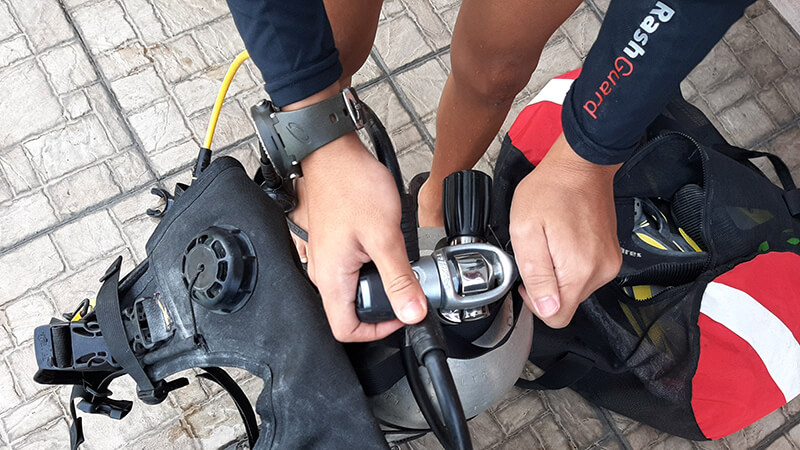
Diving instructors do advice free divers to avoid diving alone. However, some people go against that rule. Doing so, they face fatal risks such as petty water blackouts. Shallow-water blackout is a leading cause of death for spearos and free divers. Dangers, even fatalities have occurred to people who were diving alone.
If they had followed the rule of diving in company, they would have avoided such risks. If you dive with a friend, they can use the right safety protocol to save you. Since one breathe involves diving without air equipment, the risks of drowning are higher if you fail to hold your breath properly.
Even though you are responsible for your free diving safety, having a friend watch your back is invaluable. A friend will look after your mask to ensure it is correctly placed and he/she can rescue you in case of a blackout. In return, you should also check after the well-being and health of your fellow divers.
Freediving too soon after scuba diving
According to diving instructors, you should never free dive immediately after scuba diving. The training also illustrates the surface interval duration between one dive and another. Moreover, the course teaches the number of deep dives to make in a day. That is why every free diver should get the right certification prior to diving. The course will give you a thorough understanding of what takes place during no air diving.
When you mix scuba diving and one breath diving, it can lead to DCS (Decompression Sickness, also called nitrogen narcosis). Experts do recommend scuba divers to wait at least twelve hours before they undertake their free breathe diving.
Hold your breath – longer than you should
When you understand the science of free diving and how it works, you would not want to push your limits. Just imagine holding one breathe for a minute or two. While in normal life you make several short/long breathes. So, running out of oxygen is risky in normal life, leave alone when under the water. That is why free divers should never go beyond their limits. Certified courses have a code of conduct regarding how deep you should go.
For instance, the safe and recommended technique to use when under water is to take a slow pace. This process will prepare your body for a deeper experience. If you encounter pain, you should abort your dive. Nonetheless, advanced divers like to push their limits. But, before they do so, they undergo serious stretches, exercises and systems to prepare for such encounters. The idea of free diving is to understand your body, its limits, and prepare both mentally and physically.
Diving weight – carrying too much weight
Carrying more weight than recommended is risky. It can lead to equalization challenges while descending or ascending. This means you will use lots of energy to get into and out of the water if you carry more weight than recommended.
Keep in mind that you only have one breathe to take you all the way down and up. In particular, you should never risk carrying lots of weight during winter free diving. Experts have a rule-of-thumb stating that your body will attain buoyancy while at 15 meters.
Shallow water blackout – Free diving dangers
The idea of free diving is to take as much breathe as possible and holding it for the longest time possible. Thus, when you make the mistake of exhaling on descent, you might lead to equalization challenges. On the other hand, when you make similar mistake when ascending, it might cause SWB (Shallow Water Blackout).
SWB occurs when the pressure in your lungs drops, thus making the oxygen reserved in your blood to move to the lungs, instead of the brain. A mistake divers make when they get SWB is to continue diving instead of aborting. Also, they fail to let their friends know what they are going through.
Diving flags – Not enough rigging
A “safety dive line” shows a corridor where safety divers predict a free diver will emerge. This secure line should have a thickness of 10 mm to provide room for adequate grip. The line aims at showing the vertical descent and ascent.
It acts as security in case a free diver gets leg cramp or loses their fin. On the other hand, free divers fail to use a visible buoy. Red and orange or any other bright color is visible enough. The buoy should be large enough to be pulled out even by two free divers coming out at the same time.
Making too many deep dives
Most free divers do not plan for the right interval between one deep dive to the other. Making many dives continuously is risky. After deep diving, you should wait at least more than five minutes before going for another. However, you should not wait for more than eight minutes.
This interval depends on the temperature of water. This precaution aims at letting gas balance to attain its normal level, which is O2 & CO2 in the Lactic Acid. When you make many deep dives within short intervals, your system will be stressed. As a result, lactic acid will build up, which is dangerous. Experts do recommend people to avoid making more than one or two free dives in a single session.
Lack of ample time to adapt physiologically
Free diving involves holding breathe and exerting your body to underwater pressure. Therefore, your body requires ample time to prepare itself for these extreme and new conditions. Water temperature could either exacerbate or aggravate challenges, thus it should be taken seriously. In as much as your body might be forgiving and flexible, you should give it time to get used to unusual conditions.
If you quickly change the depth of water without giving your body time to adapt, you might lead to a mental “wall” or physical trauma. In addition to physical adaptation, free divers make the mistake of hyperventilating. Hyperventilation refers to the act of making over 15 deep breathes in a minute before descending. As a result, the diver tenses and descends with a decreased carbon dioxide and high pulse-rate. Your CO2 and O2 should be balanced when descending. If not balanced, you will face challenges when holding breathe, leading to SWB.
Freediving Blackout – Deep Water Blackout
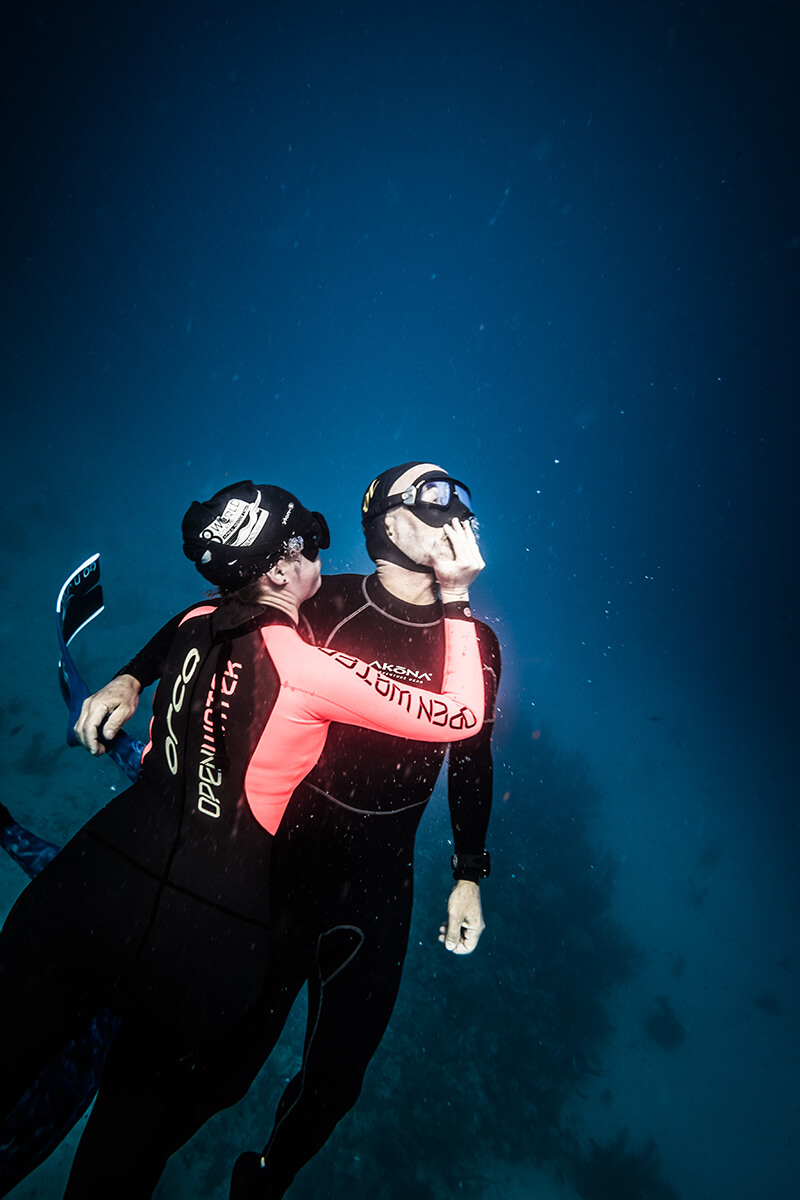
Deep Water Blackout (DWB) occurs when a diver makes a quick turn-around immediately after descending. The obvious cause of DWB is the instant decrease in oxygen pressure present in your lungs on ascent.
Although uncommon, deep water blackout occurs at depths of more than thirty feet. It is triggered by low O2 and high levels of CO2. Some survivors of diving blackouts describe it as a most peaceful manner to die. The blackouts do not give warning, clue or pain to indicate death is near. You just black out!
Free divers make the mistake of looking up while ascending and down while descending. When you look up/down, your neck will extend. This can lead to equalization challenges when either ascending or descending. Thus, blood will not flow properly to the brain. Also, the pressure in the neck baro-receptors will increase, which will send incorrect data to your central nervous system, increasing your pulse rate.
When free diving, you should minimize your movements. Doing so will preserve the oxygen necessary to maintain a low pulse rate. When you are about to make ascent, economize effort, maintain calmness and patience.
Free diving death
This should obviously take the first place in this article, but then, it is rarer than the sensational media would have you believe. Breath hold diving is a sport that looks risky, but is not all that risky. Even when you go diving as a beginner, you will not die.
However, as we have discussed in this post, there are many things to look out for. Shallow water blackout and deep water blackout are real and they do happen more often than you would believe. Therefore, take all the precautions given by your instructors to heart and never forget them. Start small and increase your dives with time.
Do not ever hold your breath longer than you should. While Tom Sietas held his breath for 22 minutes and 22 seconds, this does not mean you can do the same. If you feel that something is not right down there under the water, it is not! Start your ascent as soon as you feel so.
If you do not feel confident that you can free dive, then don’t. Let it go. It is pure and unadulterated type of diving, but the truth is… it is not for everyone.
Use free diving gear – Avoid free diving danger
All the free diving dangers that we have discussed here are avoidable, if you follow the rules. The best thing to do is to take a training course and know your limits. One breathe diving is all about knowing when you should push and when to abort.
Free diving gear is much lighter than gear made for scuba diving. When you are going down without air, you need to be as free as possible, and as relaxed as you can be.
You need a free diving mask. This is a mask made for free diving alone, with a small volume so that as you exhale to balance, there will be minimal air lost. Since you are diving on one breathe, you need to retain as much of it as possible.
Get a free diving snorkel, a special kind of snorkel that is designed to help a diver breathe comfortably with their face submerged in the water. It is made to be comfortable and the best thing is these snorkels are very affordable.
The other kind of free diving gear is free diving fins. These are designed to make your movement in the water easier and faster. Unlike snorkeling fins, these ones are full foot all the time. They are light in weight and they are made of carbon, fiber or plastic.
Follow the rules of not diving alone, never make quick turns, give your body time to adapt before changing depth, and never carry over weight objects, among others. Concisely, this kind of diving is a lot of fun and it is safe if done within the code of ethics. Free diving dangers are avoidable, now that we have identified all the hazards here.
